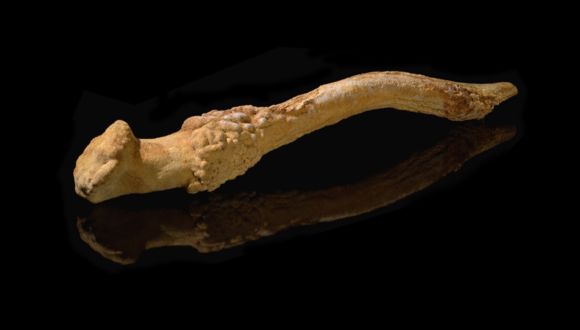Is This the Birthplace of Religious Rituals?
A rare discovery of early rituals in the levant.
A rare discovery of early rituals in the levant.
A rare prehistoric ritual complex has been uncovered in the darkest depths of Manot Cave in Western Galilee, Israel. The complex is enclosed naturally by impressive stalagmites that create a distinctive entrance to the site and feature a unique and impressive rock with geometric engravings resembling a turtle shell. The study of this complex, published in the journal PNAS, was led by Dr. Omry Barzilai from the University of Haifa and Israel Antiquities Authority, Prof. Ofer Marder from Ben-Gurion University, and Prof. Israel Hershkovitz from Tel Aviv University.
"The rare discovery provides a glimpse into the spiritual world of Paleolithic hunter-gatherer groups who lived in our region approximately 35,000 years ago. The engraved rock was deliberately placed in a niche in the deepest, darkest part of the cave. The turtle-shell design, carved on a three-dimensional object, indicates that it may have represented a totem or a mythological or spiritual figure. Its special location, far from the daily activity areas near the cave entrance, suggests it was an object of worship. Notably, there are prehistoric caves in Western Europe, with similar findings testifying these places held symbolic importance and served for ritual and communal activities", said Dr. Barzilai.

Research team (Left to right): Prof. Ofer Marder, Prof. Israel Hershkovitz & Dr. Omry Barzilai. Photo credit: Dr. Omry Barzilai.
Manot Cave has been excavated systematically since 2010 by the Israel Antiquities Authority, Tel Aviv University, and Ben-Gurion University. The cave is particularly well-known for its stunning stalactites and remains of habitation from several prehistoric cultures of the Upper Paleolithic period. Among its notable discoveries is a 55,000-year-old modern human skull, the oldest modern human fossil found outside Africa.
Ancient Rituals That Shaped Early Societies
In the course of study of the deep complex study, the researchers uncovered ash remains in one of the stalagmite rings near the engraved rock, confirming the use of fire to illuminate the ritual space, likely with torches. Acoustic tests revealed that the complex has enhanced natural acoustics, which could have created a unique auditory experience for communal activities such as prayer, singing, and dancing. Prof. Hershkovitz: "This is an unprecedented discovery of a space with 'audio-visual equipment' centered around a ritual object (the turtle), constituting the first evidence of communal rituals in the Levant. It is no surprise that prehistoric hunters chose to conduct their rituals in the darkest part of Manot Cave, as darkness embodies sacred and hidden qualities, symbolizing rebirth and renewal. Establishing ritual centers during the Upper Paleolithic was a central element in the development and institutionalization of collective identity — a necessary stage in the transition from small, isolated hunter-gatherer groups based on blood ties between individuals to large, complex societies".
The chronological age of the ritual complex in Manot Cave was dated to 35,000–37,000 years ago, a period associated with the sudden emergence of the Aurignacian culture, known in Europe for its symbolic objects and cave paintings. "In our excavations in Manot Cave, we uncovered rich Aurignacian layers near the cave entrance that included flint tools, bone and antler implements, and shell beads", said Prof. Ofer Marder from Ben-Gurion University.
In a small, hidden chamber adjacent to the ritual complex, a complete deer antler with signs of use was discovered. "Antlers were used as raw material for crafting tools for various purposes by Upper Paleolithic cultures in Europe, and by the Aurignacian culture in the Levant. The placement of the deer antler in a hidden chamber adjacent to the ritual site may be connected to the ritual activities in the cave", explained Dr. Barzilai.

A deer beam from the hidden hall in Manot Cave (Photo credit: Dafna Gazit, Israel Antiquities Authority).
The geometric engravings found on the turtle shell-shaped rock were scanned with a unique confocal microscope capable of capturing extremely thin horizontal sections. "We identified fine micro-linear scratches inside some of the grooves, confirming without a doubt that the engravings are the work of human hands. These carvings are evidence of our ancestors' artistic skills and their deep connection to rituals and symbols", said Prof. Rachel Sarig from the Dental Medicine Laboratory at Tel Aviv University, who conducted the scans.

A turtle shell-shaped rock with geometric carvings (Photo credit: Clara Amit, Israel Antiquities Authority).
The researchers also conducted 3D photographic mapping of the cave. "We found a clear separation between the ritual complex and the areas of regular activity at the cave entrance. This observation strengthens the hypothesis about the significance of the complex and the need to differentiate it from the areas where daily activity took place", said Alexander Wigman from the Israel Antiquities Authority.
According to the researchers, the discovery of the ritual complex in Manot Cave sheds new light on the spiritual life of the Upper Paleolithic people in the Levant. "This research enriches our understanding of prehistoric humans, their symbolic world, and the nature of the worship rituals that connected ancient communities. Identifying communal rituals in the Paleolithic era marks a breakthrough in our understanding of human society and offers more than just a glimpse into ancient ritual practices. It reveals the central role of rituals and symbols in shaping collective identity and strengthening social bonds", the researchers concluded.
The Manot Cave project is supported by the Dan David Foundation, the Israel Science Foundation, the United States-Israel Binational Science Foundation, the Irene Levi Sala CARE Archaeological Foundation, and the Leakey Foundation. The research involved experts from the Israel Antiquities Authority, Cleveland State University, the Geological Survey of Israel, the Hebrew University of Jerusalem, the University of Haifa, Tel Aviv University, Ben-Gurion University, the University of Vienna, the University of Barcelona, the University of Siena, and Simon Fraser University.






